Always Better Together Focus on Community

























Dear Readers,
As we get ready to turn the page on 2024 and welcome 2025, holiday celebrations turn to personal reflections, business plans and strategies for a new year. The Frederick County business community has an exceedingly impressive list of ways that those plans come to fruition.
In this issue we share FITCI’s 20-year legacy of commitment to fostering healthy economic growth and support for local entrepreneurs. We also get a look at the impressive honorees in the annual African Americans of Excellence event. Frederick is home to one of the country’s most unique holiday experiences, Sailing Through the Winter Solstice, and in this issue we highlight the tireless work of business sponsors, volunteers and nonprofits who make the creek shine.
We are also pleased to welcome Frederick County Executive Jessica Fitzwater to our pages as she looks to the county’s future. Her administration is preparing a variety of initiatives and programs for the betterment of the Frederick County community.
As we head ino 2025, may we all strive to see the best in ourselves, our community and each other, because we are truly better together. Cheers and best wishes!
and the entire staff at Pulse Publishing
12 S. Market Street, Suite 101 Frederick, MD 21701 p. 301-662-6050 | f. 301-662-5102 www.FrederickBusiness.com
Frederick Business is a bimonthly publication of Pulse Publishing, LLC. Customer inquiries should be directed to Pulse Publishing, LLC. Manuscripts, drawings, photography, and other submissions must be accompanied by a stamped, self-addressed envelope. The Frederick County Guide is not responsible for unsolicited material.
All contents of this publication are protected by copyright and may not be reproduced in whole or in part for any reason without prior consent of the publisher. Frederick Business makes every effort to ensure accuracy of its resource listings, but does not hold responsibility for incorrect or missing information.
We wish to thank our advertisers for their continued support! Many thanks to the countless Frederick County residents and employees who offered their time and insight to add to the content of this issue.

On the cover: Leslie Barnes-Keating and Jessica Fitzwater attending last year’s AAOE Event.
Photo courtesy of AAOE
PUBLISHER
Donna S. Elbert donna@pulsepublishing.net
EDITOR/CREATIVE DIRECTOR
Melissa Howes-Vitek melissa@pulsepublishing.net
DIRECTOR OF OPERATIONS
Gabby Mongeau gabby@pulsepublishing.net
BUSINESS DEVELOPMENT
Ron Cramer ronald@pulsepublishing.net
MARKETING DIRECTOR
Susan O’Connor susan@pulsepublishing.net
COPY EDITOR
Molly Fellin Spence molly@pulsepublishing.net
GRAPHIC DESIGNER
Ana Lazo Eastep
CONTRIBUTING PHOTOGRAPHERS
Yemi Fagbohun
Bill Green
Tiffany Kowalsky
Susan Larson
Susan O’Conner
Sean Reel
DISTRIBUTION distribution@pulsepublishing.net




April Bartel is a freelance writer with 25 years experience exploring topics ranging from business and tourism to great food and more. It’s the best job in the world because she gets to meet interesting people with a passion for what they do and learn new things every day, then share those stories.
Chris Slattery is an avid storyteller who covered the arts and entertainment for The Gazette and the Arts & Humanities Council of Montgomery County’s CultureSpotMC and now writes for a variety of corporations and publications while procrastinating over several unfinished works of fiction.
Molly Fellin Spence is an accomplished writer and editor with more than two decades of experience in the world of journalism. She’s worked with a variety of print and digital publications in the Mid-Atlantic region creating and honing compelling content to engage readers. A native Pennsylvanian, she has called Frederick, Maryland, home since 2002.

Jessica Fitzwater is the Frederick County Executive, dedicated to creating a community where all 270,000 residents can live, work, and thrive. A former County Council member, she has led efforts to expand affordable housing, combat human trafficking, and address climate change. Jessica grew up in Smithsburg, holds degrees from St. Mary’s College of Maryland and Hood College, and lives in Frederick with her two children.
2024has been an exceptional year for Frederick County. Our manufacturing and technology sectors are thriving, making new investments and creating good jobs in our community. Innovative new businesses, such as InventWood, launched. Existing businesses – Theradaptive, Lonza, and Hercules Custom Iron, to name a few – expanded their operations, while others celebrated major milestones. Mount St. Mary’s University’s Frederick Campus marked its 25th anniversary, and Woodsboro Bank celebrated an amazing 125 years!

My administration is focused on keeping that momentum going. I’m excited to share some of the projects you will be hearing about in 2025.
Our Office of Economic Development is working with nearly 90 prospective businesses looking to move here in the coming months. Our reputation as a hub for the biotech, advanced manufacturing, and cybersecurity industries is known throughout the region. Stay tuned for some exciting announcements in the coming weeks.
We are also looking into ways we can support other industries. For instance, we will be conducting a Creative Economy Analysis. The goal will be to determine what business development tools are needed for companies that produce intellectual works and arts, such as publishing, visual and fine arts, and media.
Other initiatives are taking shape this year. We are putting final touches on a Disparity Study that will identify steps Frederick County Government can take to support small companies that want to do business with the County. Applications have started to come in for our innovative EmPower Loan Program. And thanks to funding from the Maryland Technology Development Corporation, we are planning a Makers Space feasibility study. And we are excited about a retail popup incubator the Office of Economic Development is developing for the spring.
One of local government’s key roles is to prepare for our community’s long-term economic needs. In Frederick County, one of the ways we are doing this is through our Livable Frederick Master Plan workgroups. Residents and businesspeople are engaged in a range of topics, such as green infrastructure, investing in workers and workplaces, and housing.
If you have an interest in these areas, come to a meeting and share your ideas. You can find details at FrederickCountyMD.gov/LivableFrederick.
Our employers need students who are prepared to enter the workforce. That’s why we are creating marketing materials about career pipelines, like bioscience. Workforce Services is working with Frederick Health to ensure there are enough trained nurses to meet the needs of our community. And partnerships like the one Frederick County Public Schools has with Frederick Community College and others allow students to take courses in agribusiness, skilled trades, and health professions. It’s no wonder our Career and Technology Center has struggled to keep up with the growing needs of our students.
That’s why I am excited about the work we are doing to expand workforce training options for students. Last fall, we organized a Steering Committee for a Career and Technical Education Strategic Master Plan. This group includes representatives from FCPS, FCC, Frederick County Workforce Services, and the Chamber of Commerce. They will examine our existing Career and Technical Education facilities and offerings, and then recommend steps we can take to build a world-class career and technical education program.
I recently announced plans to stand up a new Business and Industry Council that can guide these efforts and more. Members of the council will be announced in January.
Also in January, the county will host its second annual Business Insight Forum. We’ll unveil the results of the most recent Business Sentiment Survey. The keynote speaker will be an economic expert from the global real estate firm CBRE. Watch DiscoverFrederickMD.com for details about the event and how to register.
I am excited by the possibilities the new year holds for our community. At the same time, I plan to take a cautious, practical approach as I develop the county’s next budget. Last year, we addressed critical school construction funding needs. This year, with the state facing its worst deficit in two decades, we are preparing for a lean county budget. We must be strategic in our investments. Directors are being required to align their budgets with the goals of Livable Frederick. By taking a data-driven, community-informed approach, we will move Frederick County forward in 2025.
IN PARTNERSHIP









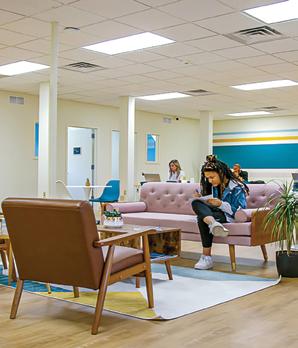


Just off I-70, 8 miles east of Frederick, there’s New Market. A hidden gem that’s been around since George Washington was president, New Market was originally a stopover on the National Road for travelers headed west. Today, New Market is a place to visit and relax with family and friends. Stroll along historic Main Street, grab a bite to eat at one of our restaurants, visit our one-of-a-kind shops, all locally owned, check out the public art in the Community Park. Free and convenient parking; shops with a smile.
To learn more, especially about our events, such as our June Block Party and the December Christmas Parade, check our website: www.townofnewmarket.org/small-town-fun
Friendly shops, tasty food, and pretty streets— New Market






Where do executives and small business owners go to tune into the latest trends and cultivate inspiration? We asked a few of our contributors for their top picks in print and podcasts.

By Gino Wickham
One book that has truly influenced the way I approach business is “Traction” by Gino Wickman. As someone who plays a key role in shaping growth and development at Contour Construction, “Traction” has been instrumental in providing a clear framework that helps us move from just having goals to actually achieving them. It’s not just a book about theory—it’s packed with practical strategies that any business can adopt to drive meaningful results.
What initially drew me to “Traction” was how it provides a clear path for aligning all parts of the business. It’s easy to get lost in the weeds of daily operations, but Wickman’s Entrepreneurial Operating System (EOS) gives you a way to stay focused on the bigger picture without neglecting the details that matter. The

six key components—Vision, People, Data, Issues, Process, and “Traction”— offer a structured approach to creating alignment within your team and ensuring everyone is working toward the same objectives.
One of the biggest takeaways for me has been how “Traction” emphasizes the importance of measurable progress. Implementing the scorecards and data tracking that Wickman outlines has transformed how we make decisions at Contour Construction. Instead of relying on gut instinct, we now have the tools to track key performance indicators and ensure we’re always
moving in the right direction. This focus on accountability has been crucial in helping us maintain momentum as we grow.
Beyond just the business strategies, what I appreciate about “Traction” is that it’s not written just for owners— it’s valuable for anyone in a position to drive change or improvement. Whether you’re leading a team or contributing to a larger organizational effort, the lessons in “Traction” are adaptable and actionable.
I highly recommend “Traction” to anyone serious about improving how their business operates. At Contour Construction, we’ve seen the impact it can make, and I believe it has the potential to help others looking to strengthen their business, build sustainable growth, and stay focused on what really matters.

Joshua Bell Director of Business Development: Contour Construction
By Stephen Covey
The most resourceful book of my personal and professional life is “The Seven Habits of Highly Effective People,” by Stephen Covey.
I apply at least one of the habits Covey writes about in this book every day.
This book is empowering, teaching how to put first things first and control your end game. It reminds you that once you get out of your own way of thinking, positive things happen.
I was introduced to the book during graduate school, and I will admit, I didn’t take it seriously. I couldn’t relate to why the professor focused on this book that seemed to have nothing to do with my major. The professor was obviously a Covey guru which annoyed me, yet still piqued my curiosity.
I soon realized my professor was giving us tools for success, and no matter our backgrounds, interests or goals, the “7 Habits” were applicable because, it isn’t about what you do, it’s the mindset you bring to doing it.
“Name three words you would use to describe yourself.” The classic interview question we’ve all faced when applying for a job we’re not entirely sure we’re qualified for. And other than honest and dependable, what’s the one word we all choose to use?

I will share my favorite two habits: being proactive and seeking understanding.
I’ve been told I am proactive to a fault. I probably analyze way too much, seeking an informed decision. I figure if my decision turns out well, then I’ve prepared myself for it. If it doesn’t,
I’ve still used all that I had within my control and can relinquish what didn’t work out.
Because my job is centered on diversity and inclusion, I am heavily focused on understanding. I gather as much information as I can about others’ points of view, then apply my own knowledge and experiences. This creates synergy toward progress. And, that’s a win-win!
After all these years, I continue to sharpen my saw by reading Covey’s works. He has many beyond “7 Habits.” His book, “Principle-Centered Leadership” currently sits on my nightstand.
It’s never too early or too late for growth and empowerment. I implore you to seek out Covey’s books and apply their lessons to your own situations.

Endia Snowden, Sr. Business Development Manager, Frederick County Office of Economic Development
Adaptable.
I can only speak from personal experience, of course, but in the world of digital marketing, many of us are expected to pivot on a dime. New tools come out daily that change workflows, and our day-to-day tasks look different every passing week. That’s why, if I can offer one piece of advice, it’s to emphasize the importance of self-education!
That’s where Udemy has consistently found a place in my after-hours learning. The platform offers courses on marketing niches like graphic design and photography, while also featuring more intensive courses like web
continued page 14


development and IT certifications. If there’s something you’re looking to learn to build your skills and level up in your career, Udemy probably has something for you.
The best part? It’s cheap. I think the most I’ve paid is $25 for a course. And I’ll stack up the education I’ve gotten from the three courses I’ve taken next to my four-year degree. If you put the energy into the coursework and stay consistent with your learning, I guarantee there’s no way you can’t level up your career with these resources available.

Are you a small business owner looking to maximize tax savings and boost your cash flow? At BMC, we specialize in providing tailored advisory services that help you build a robust financial strategy. Our expert team is dedicated to understanding your unique needs and delivering solutions that drive growth and efficiency.
• Strategic Tax Planning: Our advisors work with you to develop a comprehensive tax strategy that minimizes liabilities and maximizes savings.
• Cash Flow Optimization: We help you identify opportunities to improve cash flow, ensuring your business remains financially healthy.
• Exceptional Communication: We pride ourselves on maintaining clear and consistent communication, keeping you informed every step of the way.
• Next Level Service: Our exclusive Next Level program offers proactive strategic planning and monthly financial reviews, empowering you to take your business to new heights.
Partner with BMC and experience the difference that expert advisory services can make. Contact us today to schedule a consultation and start your journey towards financial success.

By Brett Hess, President and CEO of BMC Accounting

Brett Hess is the President and CEO of BMC, continuing the legacy of his father, Peter Hess, as a forwardthinking leader focused on strategy, culture, and innovation. He is also a partner in BMC Insurance, LLC, and Veterinary Software Associates, LLC. In addition to his professional roles, Brett is committed to supporting local nonprofits and fostering community engagement.
Maintaining a healthy cash flow is crucial for the sustainability and growth of any business. Small business owners know that a healthy cash flow ensures you can meet your obligations, invest in opportunities, and weather unexpected challenges. One of the most effective ways to improve cash flow is through strategic tax planning. By taking advantage of tax planning opportunities you can significantly reduce your tax burden and retain more of your hard-earned cash.
Cash flow refers to the net amount of cash being transferred into and out of your business. Positive cash flow means your business is generating more cash than it is spending, which is essential for growth and stability. Negative cash flow can lead to financial strain and potentially jeopardize your business’s future.
The Role of Tax Planning
Effective tax planning is a powerful tool for improving cash flow. By strategically managing your tax obligations, you can minimize the amount of cash that goes to the government and maximize the amount that stays in your business. Here are some key tax planning strategies to consider:
1. Entity Status Elections
Choosing the correct entity status for your business can have a significant impact on your tax liabilities. Electing to be taxed as an S-Corporation (S-Corp) can provide substantial tax benefits. S-Corps allow income to pass through to the owners’ personal tax returns, avoiding double taxation on corporate income. Additionally, S-Corp owners can take advantage of lower selfemployment taxes on a portion of their income, further enhancing cash flow.
2. Tax Deductions and Credits
Taking full advantage of available tax deductions and credits can also improve your cash flow. Common deductions for small businesses include expenses related to office supplies, equipment, travel and employee benefits. Tax credits, such as those for research and development or energy-efficient improvements, can directly reduce your tax liability, freeing up more cash for your business. Note: Some of these tax credits may expire in 2025, so it’s important to maximize opportunities now.
3. Timing of Income and Expenses
Strategically timing the recognition of income and expenses can help manage your tax liability. For instance, deferring income to the next tax year or accelerating deductible expenses into the current year can reduce your taxable income and improve cash flow.

4. Retirement Plans
Contributing to retirement plans not only helps secure your future but also provides immediate tax benefits. Contributions to qualified retirement plans, such as a SEP IRA or 401(k), are tax-deductible, reducing your taxable income and enhancing cash flow.
5. Income Shifting
By employing your children in your business, you can shift income to them and it will be taxed at a lower rate. This not only reduces your taxable income but also keeps more cash within your family.
6. The Augusta Rule
This tax law loophole allows you to rent your home to your business for up to 14 days per year without being taxed on the rental income. Hold business-related meetings or events at your home a few times each year and your business can compensate you at the fair market rate for using your home, allowing you to earn that income tax free.
7. Section 179 Deduction
Businesses may deduct the full purchase price of qualifying equipment and software they purchase or finance during the tax year. This can significantly reduce taxable income and improve cash flow by allowing you to invest in new assets without a large tax burden
Effective cash flow management is essential for the success of any small business. By leveraging strategic tax planning opportunities, you can significantly reduce your tax burden and retain more cash within your business. As your local CPA firm, we are here to help you navigate these strategies and optimize your cash flow. Contact us today to learn more about how we can support your business’s financial health and growth.
IN PARTNERSHIP

Businesses and Community Give Back in an Illuminating Way
Shining a light on nonprofits

The boats have officially launched along Carroll Creek Linear Park! What began in 2016 as a solitary sailboat glowing in the water has grown into an entire fleet of various vessels, 26 sailing and one land-locked, designed to celebrate the season and give back to the community by supporting a variety of nonprofits and in the process creating an annual holiday tradition that brings joy to residents and visitors alike.
The glistening spectacle known as Sailing Through the Winter Solstice was made possible by the local nonprofit Color on the Creek, known for the gorgeous plant installations that have graced the Carroll Creek waterway throughout the spring and summer months since 2012.
In 2016, Dr. Peter Kremers and Kyle Thomas, founders of Color on the Creek, wanted to find a way to extend the viewing season by creating something equally as spectacular to bring visitors downtown during the winter months. So, they floated their first boat, the USS Hamster, in Carroll Creek that winter.

Since then, businesses, visitors and nonprofits have reaped the rewards of magical displays annually for about three months each winter. The event helps the community in several different ways.
First, Frederick businesses are invited to sponsor and design a boat to be on display, providing engaging exposure. One such business, Vintage MC Frederick, has been working on an exciting upgrade to its boat and regularly shares updates on its Instagram page. Votes for Vintage MC Frederick’s boat, The Dancing Queen, continued page 21





Alley Cat
Steadfast provides safe housing in a caring, supervised, and home-like environment for unaccompanied homeless youth.
Angel Falls
The Housing Authority of the City of Frederick (HACF) is dedicated to providing safe, affordable housing and empowering families.
Arctic Racer
Centro Hispano de Frederick has been helping the Frederick immigrant population to succeed in our community.
Black Pearl
Downtown Frederick Partnership works to enhance, promote and preserve the vitality, livability and diversity of Downtown Frederick
Colleens Crew
The Cystic Fibrosis Foundation
Dancing Queen
Operation Paws for Homes is devoted to the rescue, rehabilitation and placement of dogs and cats who deserve caring forever homes.
Digital Drift
We are dedicated to uniting technology enthusiasts, professionals, and organizations through education and a supportive community.
Holly Jolly Roger SOAR - Supporting Older Adults Through Resources
Hope Floats
Hurwitz Breast Breast Cancer Fund helps provide the best technology and services for the early detection and treatment of breast cancer
It’s A We Thing
Key City Rotary’s mission is to make a meaningful difference in Frederick County and beyond by putting our values into action.
Kracken
Color on the Creek is an all-volunteerinspired and managed water garden located in the Carroll Creek Linear Park
Magers Honor
Honoring Coach Magers’ legacy which will create lasting opportunities for children to thrive in the sports he loved.
Mass Ascension
Project GUIDE Their mission is to educate, advocate and encourage the next generation into the trades. Providing a pre-apprenticeship program offering youth ages 16-24 job readiness, technical skills training, and paid internship opportunities with local businesses in fast-growing industries.
Resilience
Children of Incarcerated Parents
Partnership (COIPP) Their mission is to foster the growth of strong, resilient, hopeful children who are impacted by the incarceration of a loved one.
Ribbon Cutter
City Youth Matrix is a local nonprofit that removes barriers so children can experience the wealth of enrichment opportunities.
Rotary Magic
The Splash Point at Baker Park. It will be Frederick County’s inaugural free public splash pad, a vibrant tribute led by the Turner family.
Sea Sharp
Frederick Children’s Chorus encourages and empowers young individuals to engage in singing and music as a means of self-expression
Seva
Women’s Giving Circle of Frederick County cultivates philanthropy among women in the Frederick, Maryland area.
Snallygaster and Twins
Color On The Creek is an all-volunteerinspired and managed water garden located in the Carroll Creek Linear Park.
SS Greater Good
The Delaplaine Arts Center provides the Frederick region with educational opportunities and experiences in the visual arts through classes.
(List as of press time)
SS Pinwheel
Friends of the Child Advocacy Center
Child Abuse Prevention in Frederick County, Maryland
Starry Night
Heartly House helps to fight domestic and sexual violence in our communities.
The Chesapeake Bay Retriever
SHIP, the Student Homelessness Initiative Partnership provides critical resources and urgent services to the hundreds of Frederick County youth experiencing homelessness.
U.S.S. R.W. Warner
The Frederick YMCA is a nonprofit organization working with community partners to improve the lives of children, adults & families.
Vasa
Frederick Health Hospice is a community based nonprofit dedicated to helping others live fully.
Wings Over Carroll Creek
Experimental Aircraft Association (EAA) Provides scholarships and technical support to motivated local youth who demonstrate a strong interest in flying.
Zodiac
Days End Farm Horse Rescue is one of the largest horse rescue organizations in the Mid Atlantic area.

by
by


The 2023-24 season raised more than $133,000 for charities in Frederick County.
will benefit Operation Paws for Homes, a nonprofit that has rescued more than 12,000 dogs and cats in need since 2010.
Second, installing the boats and making sure they are properly moored and secure provides an opportunity for more than 40 volunteers to take part in making the event happen. Finally, it is a competition during which the results equal donations that then provide funding to the boats’ affiliated local charity. Community members and visitors have the opportunity to support local nonprofit organizations by voting for their favorite boat via donations. This year, a $5 donation equals one vote. The boat with the most votes at the end of the season is declared the winner of a Sailing through the Winter Solstice Trophy.
The 2023-24 season raised more than $133,000 for charities in Frederick County. This year Sailing Through the Winter Solstice will be on display from Nov. 23, 2024 through March 8, 2025 and can be enjoyed anytime, free of charge.
Because of the festive fleet, Carroll Creek Linear Park takes on a festive vibe and additional fun is offered through the season, such as holiday markets, caroling, interactive games, a DJ, food trucks and the occasional boat ride down the creek depending on water conditions, the weather and the captain’s availability.
It’s also become a spectacular backdrop for the city’s New Year’s Eve Candlelight on the Creek celebration and Key Drop. 3

By Molly Fellin Spence
Photos by Susan O’Connor
In 1978, 24-year-old Graham Baker opened La Paz Mexican Restaurant in Downtown Frederick, never anticipating he would still be serving chips and salsa to Fredericktonians in 2024.
After more than 46 years of operating the much-loved eatery, Baker is ready to move on, celebrate his wins and enjoy the time he and his wife, Marcie, have left together.
Baker listed La Paz, and the building it has called home for half its life, for sale in September.
“We are the oldest restaurant in continuous ownership downtown,” Baker said, noting that Wag’s, across Market Street, runs a close second. Brewer’s Alley and Crabapples Deli were close to the record as well, until both were sold to new owners in recent years.
Baker hopes to sell to someone who’s willing to keep La Paz, its recipes and traditions alive.
“We put it out there – here we are, the building and business are for sale. For 46 years we’ve been trying to do the best for the community and the community has been absolutely wonderful,” he said. “Now it’s time to move on.”
It is almost unheard of for a restaurant to last as long as La Paz has.
The National Restaurant Association estimates that about 60% of restaurants fail in their first year of operation, while 80% close within five years of opening.
“Any kind of food business is one of the most difficult type of industries to maintain over the long haul,” said Richard Griffin, director of economic development for the City of Frederick since 2002. “It’s a lowmargin business. You have to serve a lot of dinners and turn the tables many times in a night. … To last 40-plus years is remarkable.”
Most Frederick restaurants that are successful long-term are run by independent restauranteurs offering a

Most Frederick restaurants that are successful long-term are run by independent restauranteurs offering a unique experience, Griffin said, and La Paz has long fit that bill.
unique experience, Griffin said, and La Paz has long fit that bill.
Baker credits his simple and delicious menu and reasonable pricing for La Paz’s success.
“Our mainstays – the salsa, queso, sangria, margaritas – all that stuff has been pretty much exactly the same from day one,” Baker
said. “We’ve changed some of the spicing, back in the day we were introducing Frederick to our brand of Mexican food and we didn’t want to overheat it. After 46 years we don’t really try to go for the heat, we go for the flavor.”
La Paz opened in 1978 at 18 Market Space, a charming nook off North Market Street, behind Brewer’s Alley. continued next page
Though Baker grew up in Frederick, he was living in Denver at the time and was thinking about opening a restaurant out there. A skiing accident changed his plans.
He spent a few months back in Frederick following shoulder surgery and during his convalescence he got hooked on the new vibe happening downtown, led by thenMayor Ron Young. The 30-something led a huge revitalization of downtown as mayor in the late 1970s and 1980s, implementing flood-control measures and luring businesses back to Market Street.
“They were trying to bring back business to downtown, and it just became obvious this was the spot (for my restaurant),” Baker said. “It’s my hometown.”
Though his degree from the University of Denver is in psychology, he remembers walking by the university’s renowned hotel/ restaurant/hospitality school every day on his way to class and, ironically, never taking a class. He had learned to cook Tex-Mex food when living in Colorado and recognized a market for that type of food in Frederick.
For its first two years, the self-taught cook spent most of his time in the back of the house at La Paz, developing recipes and creating dishes. Though he’s moved on to more administrative tasks in recent years, he still buses tables regularly and heads back into the kitchen when he gets the chance, calling it his “comfort spot.”
Whether it’s the Frederick-famous margarita on the rocks, the shredded tomato salsa and fried tortilla chips offered to every table upon arrival, or Marcie’s choice salad, named for Baker’s beloved wife, “just about every recipe has been the same from the beginning, and I think that’s what makes us unique,” he says.
Even as Frederick has changed, and more Mexican restaurants have opened, Baker says his customer base has stayed loyal and consistent: “Our customers, some of them have been with us for 46 years, and this kind of Mexican food is what they’ve grown accustomed to.”
In the early 2000s, Baker had been running La Paz for a few decades and was content at 18 Market Space. He had acquired



. . . “just about every recipe has been the same from the beginning, and I think that’s what makes us unique.”
- Graham Baker, owner/operator
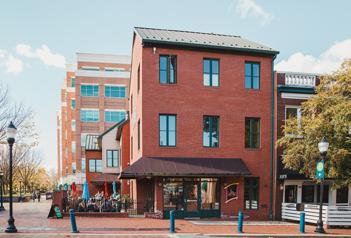

a neighboring building and was making plans to purchase more land to allow for outside dining. Then the city came knocking.
A desire to expand and modernize the nearby Church Street public parking deck included plans to buy 18 Market Space and tear it down.
“That was the catalyst for us to make a change,” Baker said, though the city still has not followed through with its plans and 18 Market Place still stands.
When looking for La Paz’s new home, Baker knew the restaurant had to stay in Downtown Frederick: “That was our ideal. We loved the downtown environment.”
At the same time, the city was working through its initial $6 million investment in upgrades to Carroll Creek Park. The creek was a utilitarian flood-control measure at the time, and then-Mayor Jennifer Dougherty spearheaded efforts to upgrade the dull stretch of concrete sidewalks surrounding the waterway into something much more vibrant.
Part of the work included working with the Federal Emergency Management Agency to analyze the business district and ultimately remove FEMA’s 100-year floodplain designation.
The change allowed entrepreneurs to access less expensive insurance and source equity to renovate existing spaces and build new businesses, Griffin says, which was crucial to making Carroll Creek the vibrant corridor it is today.
“The city owned the land around the creek and always had the intention to sell it to developers to build on, add restaurants, offices, and shops,” Griffin said. “For the first time people were willing to invest in that part of downtown.”
Baker was one of those investors.
He purchased the creekside property along South Market Street where La Paz now sits, and created the restaurant from the ground up.
La Paz’s new location has two floors, like its original home, with two bars and lots of quaint charm. But the South Market Street spot allowed for double the seating, plus plenty of space for outdoor dining.
“La Paz was the first to open with outdoor dining on the creek. The city continued next page



“We hear so many family stories, what (the restaurant) has meant for people,” he said. “People have come here with regularity for birthdays, wedding rehearsal dinners, first dates. La Paz has been a destination for Frederick celebrations, it’s a very comfortable gathering place.”
- Graham Baker, owner/operator
encouraged that. The goal was to have outdoor dining and create that atmosphere downtown,” Griffin said.
For Baker, the move was “glorious.”
“For some of our customers, it was hard for them to make the switch, but everything stayed the same food-wise, drink wise,” he said. “Do I regret moving? Unequivocally no. This gave us more visibility, a bigger footprint and outside dining. That’s huge. We were the first ones down here.”
To operate for 46 years, through economic downturns, changing tastes, and most recently a global pandemic, takes a special restaurant run by a special family.

Graham Baker’s last name should be familiar to most people who know Frederick. His family has a long history of contributions to the city, and its most famous sprawling public park is named for his ancestors.
Baker’s late father, Joe, was an original board member of the Greater Frederick Development Corporation, now known as the Downtown Frederick Partnership, which manages the city’s Main Street program, working “to enhance, promote and preserve the vitality, livability and diversity of Downtown Frederick.”
And his late mother, Fran, was elected twice to the city’s Board of Aldermen, ran for mayor, and is credited with contributing to the revitalization of the city’s downtown.
The Trail House, another Downtown Frederick mainstay, was opened by Baker’s sister and brother-in-law, Gerry and Clyde Hicks, in 1984 just a few doors down from La Paz’s current location. The outdoor store is now owned and operated by the Hicks’ son, Drennan, and his wife, Catie.
“There really has been a family investment in Downtown Frederick, personally, over the course of many decades, by the Baker family,” Griffin said.

For his part, Graham Baker says family has always been at the heart of La Paz.
“We hear so many family stories, what (the restaurant) has meant for people,” he said. “People have come here with regularity for birthdays, wedding rehearsal dinners, first dates. La Paz has been a destination for Frederick celebrations, it’s a very comfortable gathering place.
“I think that’s the most gratifying thing of the 46 years, is being involved in the community for the better. And being a part of individual families’ memories.”
During five decades of business, La Paz has successfully weathered recessions and inflation, and most recently a global pandemic.
The secret, Baker said, is La Paz’s “very good price point, sometimes to our own detriment.”
Even when budgets are tight, a night out at La Paz is still affordable for most, he says: “They may not come in quite as often, but they’re still able to do it.”
When the order came down in March 2020 banning all in-person dining amid the COVID-19 pandemic, La Paz’s staff pivoted quickly to takeout-only, taking advantage of a temporary change to liquor laws that allowed patrons to pick up to-go cocktails
and get their La Paz margarita fix alongside deconstructed tacos and enchiladas, reassembled at home.
Baker credits his staff for their seamless implementation of the temporary business model and his loyal customers for keeping La Paz alive during a challenging time for many.
La Paz remains open as its owner looks for a buyer. He’s hopeful whoever decides to purchase the property will keep it as a restaurant, and maintain the cherished spot so many in the community see as part of personal memories.
“It transcends the food. It’s a very comfortable spot,” Baker said. “It’s what I set out to do — make a spot that was accessible to everybody. You can come and have fun and just go away happy.”
Fitzgerald Realty Group is helping Baker handle the transaction to acquire the restaurant and/or the building that is its home.
Griffin says he’s confident they’ll find another restauranteur who will want to take over the building.
“It occupies a really prominent area of downtown, has a great reputation, good sidewalk traffic, outdoor dining,” he said. “There’s every reason to believe it will continue to be successful.” 3





By Amanda Haddaway, Managing Director, HR Answerbox

Amanda Haddaway is the managing director of HR Answerbox. If you have HR questions or need assistance with HR initiatives in your business, please contact her at amanda@hranswerbox.com. She has a team of 250+ HR/OD consultants, trainers, coaches and speakers who can assist your organization.
Awe approach 2025, organizations are navigating an evolving HR landscape that is redefining how they attract, retain, and manage talent. Keeping up with these shifts isn’t just a matter of trend-spotting; it’s about preparing now to ensure your business is agile, compliant, and well-positioned for success. Here’s a look at emerging HR trends and actionable steps you can take to stay ahead.
Businesses that haven’t embraced flexibility may struggle to compete for top talent. What started as a pandemic-driven necessity is now a long-term expectation. A study from Gartner predicts that 75% of employees expect flexibility in where and when they work.
What to Do Now: Focus on developing sustainable hybrid work policies. Consider how to maintain company culture, foster collaboration, and support employee well-being in a dispersed work environment. Start evaluating technology solutions that streamline communication and collaboration, and revisit your performance management systems to ensure they effectively measure productivity and output, regardless of location.
Mental health and employee well-being have become top priorities in the workplace, and this trend shows no signs of slowing. Research by Deloitte indicates that 68% of employers are expected to increase their investment in mental health and well-being programs next year. The shift goes beyond offering basic wellness programs—businesses are focusing on creating holistic well-being initiatives that address mental, emotional, and financial health.
What to Do Now: It’s crucial to start thinking about how well-being is integrated into your overall employee experience. Explore affordable wellness initiatives, such as flexible work hours, mental health days, or access to virtual counseling services. Open dialogues about mental health in your workplace and train managers to recognize and support employees who may be struggling.
The use of data and HR analytics is gaining traction, enabling businesses to make more informed decisions about recruitment, retention, and employee engagement. HR functions are increasingly data-driven, with AI tools and people analytics helping companies uncover patterns, predict workforce needs, and even automate aspects of the hiring process. This is particularly relevant for small businesses that may lack the resources for large HR teams but still need to stay competitive in attracting talent.
What to Do Now: Start building your HR analytics capabilities by identifying key metrics that align with your business goals. Whether it’s tracking employee turnover, monitoring the success of training programs, or analyzing compensation trends, data can provide valuable insights into how to improve the employee experience.
The pace of technological change is creating a skills gap that many companies are struggling to address. A report from the World Economic Forum estimates that 50% of employees will need reskilling or upskilling to keep pace with technological advancements.

What to Do Now: Focus on creating a culture of learning within your organization. Assess the current skills of your team and identify where gaps may exist. Encourage professional development by offering access to training opportunities that align with your business needs. Investing in your employees’ growth not only enhances their skills but also boosts retention by showing your commitment to their long-term success.
As these trends take shape, business leaders must start planning today to thrive in 2025 and beyond. By proactively addressing these emerging trends, you can build a resilient, adaptable business that attracts top talent and fosters a culture of innovation and growth.
SPONSORED CONTENT
















African Americans of Excellence Exhibit 2025


by courtesy of AAOE
Yemi Fagbohun, founder and executive director of the African Americans of Excellence, is no stranger to the spotlight.
A nationally recognized artist, he is an active and enthusiastic member of the creative community in Frederick. His own work is featured in many local businesses around Frederick County. Visitors can enjoy Yemi’s work at Creekside Plaza, Courtyard by Marriott, The Common Market, and Woodsboro Bank, to name a few. His murals The Pillars of Frederick, Historic Thurmont and the Frederick Sports Mural at Harry Grove Stadium aim to inspire all who pass by.
Yemi’s vision to help shine a light on those in the community who had not yet experienced the warm glow of recognition for their contributions began in 2023 with the first African Americans of Excellence Exhibit. His desire was to get to the heart of community, bring all people together through the arts to help celebrate, support and heal.
That first event, held at the Gaslight Gallery on East Church Street in Downtown Frederick featured no music, no hors d’oeuvres nor fancy charcuterie boards, yet was still quite a success. Guests crammed into the space to witness artists and community come together in celebration of the special honorees. Yemi says he knew it was a success when months later, attendees expressed how much they enjoyed the event and how they were impacted by the experience. He was told, “What an amazing night! We may have been hungry and thirsty, but that room was filled with such love!”
Yemi along with a 17-member advisory board that includes a variety of community leaders, business owners and nonprofit representatives, are thrilled to announce the next iteration of the event.
Now in its third year, the 2025 AAOE Exhibit Kick-Off will be held at the Weinberg Center for the Arts on Wednesday, Feb. 5.
The AAOE Exhibit is a multimedia exhibit of original work from various local artists, which will showcase the contributions

of amazingly talented African Americans in Frederick County as a way to celebrate and appreciate the contributions of African Americans to the local Frederick community as well as the world.
Members of the African American Resources, Cultural Heritage (AARCH) Society of Frederick County, selected the seven honorees who will be portrayed through various creative media in this exhibit. The decision to honor individuals while they are living rather than posthumously, was a conscious decision made to provide an opportunity to inspire the next generation. It allows not only the community but also friends and generations of family members to experience the pride of knowing who each honoree is and to
provide a better, real-time understanding of what is possible.
Yemi hand-selected eight artists, seven photographers and seven videographers as well as up to 40 high school students representing public, private and homeschool students in Frederick County.
A 501(c)3 nonprofit organization, AARCH Society is committed to fostering greater understanding among diverse cultures in Frederick County, and is committed to preserving and sharing the history and heritage of African American Culture of Frederick County, while seeking to provide opportunities to share through lecture, display and tours, the impact of African Americans upon our history.
continued next page
The following seven honorees were selected for the 2025 exhibit:

Duckett is a Frederick native, the 7th generation of his family to live here. Duckett made history in November 2022, becoming the first African American elected to the Frederick County Council. He represents District 4 and was elected as vice president of the council.
A Frederick born-and-raised musician, Ambush is best known as the bass player of jazz fusion band Spyro Gyra.
A five-time Grammy nominated artist, Ambush is also an accomplished luthier; crafting all his instruments himself and selling custom-made basses through his company Ambush Basses.

Photos by Tiffany

Board member of The Community Foundation of Frederick County, Robbins retired from Alcoa, Inc., where he was director of state and local government relations. He has served as president of the Frederick County Board of Education and Frederick County Chamber of Commerce, and served on the board of I Believe in Me, Inc.
Founder of Just a Kind Note, an organization of hundreds of volunteers from all over the country who write notes of kindness and support for residents in recovery homes, domestic violence shelters, hospitals and just about anywhere someone needs the hope found in a kind word.


Founder of the nonprofit Whole Heart Center and author of “2Grieve 2Gether: A Journey from the Heart Helping Survivors & Supporters Navigate the Grief Journey,” Rollins was nominated for an NAACP Image Award in 2011 for Outstanding Literary Work by a Debut Author. Rollins’ family funeral business has built the Rollins Life Celebration Center, which provides a renewed focus of death care and grief care services. A Frederick native, Rollins serves on national advisory boards for the Tragedy Assistance Program for Survivors and the Autism Bereavement Project, as well as on the Ausherman Family Foundation.
An eighth generation Frederick Countian, Sampson is very active in the community. Currently serving as chief of staff to Frederick City Mayor Michael O’Connor, Sampson has received a number of awards and distinctions, including “Towson University Emerging Student Leader,” “Black Frederick Rising Star,” the “NAACP Youth Award of Excellence,” and the “Eliminating the Achievement Gap Man of Distinction Award.”


A native Fredericktonian, and a well-known physician on the staff at Capital Women’s Care, Dr. Thomas-Spencer is credited with the growth of the Jack and Jill of America Western Maryland Chapter interest group as well as the present chapter. Dr. Thomas-Spencer earned a bachelor of science degree in biology from the University of Maryland, College Park, in 1993. Dr. Thomas-Spencer also served in the 2290th United States Army Reserves Unit during Operation Desert Storm in 1991.
AARCH Society is a nonprofit committed to fostering greater understanding among diverse cultures in Frederick County, and is committed to preserving and sharing the history and heritage of African American Culture of Frederick County, while seeking to provide opportunities to share through lecture, display and tours, the impact of African Americans upon our history.




By Bethany Lord SVP, Chief HR and Culture Officer

As the workforce becomes increasingly multigenerational, companies are discovering the immense value of embracing diversity—not just in terms of culture or gender but also across generations. From Traditionalists to Gen Z, each generation brings its own strengths, perspectives, and challenges to the workplace. However, unlocking the full potential of these diverse voices requires thoughtful strategies to foster inclusivity, respect, and collaboration. As Sundar Pichai, CEO of Google, wisely said, “A diverse mix of voices leads to better discussions, decisions, and outcomes for everyone.” Bethany Lord has been in Human Resources for 16 years and currently holds both the Professional in Human Resources (PHR) and Society for Human Resources Management Senior Certified Professional (SHRM-SCP) designations. Bethany is a graduate of Frostburg State University where she graduated with a degree in Business Administration, concentration in HR.

Q1:
Why is recognizing generational diversity important for an organization?
Q2:
What are some common myths about different generations in the workplace, and how can we challenge them?
Generational diversity is more than just a demographic statistic—it represents a blend of perspectives, experiences, and ways of thinking. Each generation brings unique strengths to the table. For example, while Baby Boomers offer valuable experience and loyalty, Gen Z brings fresh perspectives on social responsibility and digital fluency. By recognizing and valuing these differences, companies can foster a more inclusive, innovative, and cohesive work environment.
Generational myths often stem from stereotypes that can hinder collaboration. Here are a few common misconceptions:
• Traditionalists (born before 1946): Myth - Resistant to change.
In reality, Traditionalists bring valuable wisdom, work ethic, and a wealth of experience. They may prefer clear expectations, recognition, and development opportunities.
• Baby Boomers (born 1946-1964): Myth - Technologically inept and resistant to change. Contrary to this myth, Baby Boomers have adapted to technology and are often more risktolerant, hardworking, and loyal. They value balance, rewards, and clear objectives.
• Gen X (born 1965-1980): Myth - Disloyal job hoppers.
While Gen X tends to value independence, they also appreciate stability, loyalty, and a flexible work culture. They excel in environments that foster teamwork and open communication.
• Millennials (born 1981-1996): Myth - Lazy and entitled.
Millennials are often driven, ambitious, and eager to make a positive impact. They thrive in workplaces that value teamwork, flexibility, and diversity.
• Gen Z (born 1997-2012): Myth - Only interested in technology and social media.
Gen Z is not only tech-savvy but also values authenticity, meaningful work, and social responsibility. They need a psychologically safe environment with opportunities for mentorship and team-building.
Q3: What strategies can organizations implement to foster intergenerational collaboration?
To truly harness the power of a multigenerational workforce, organizations must actively promote collaboration across age groups. Here are some key strategies:
• Mentorship Programs: Pair individuals from different generations to share knowledge, skills, and experiences. This mutual exchange helps build understanding and respect across generational lines.
• Cross-Generational Teams: Encourage the formation of teams with members from diverse age groups. Working together on projects enables employees to leverage each other’s strengths and bring diverse perspectives to problem-solving.
• Generational Awareness Training: Offer workshops or training sessions that educate employees on the differences in communication styles, work preferences, and values across generations. This can improve understanding and reduce conflict.
• Open Communication and Feedback: Create a culture where feedback is welcomed, and open communication is encouraged. This helps ensure all voices are heard, regardless of age or experience level.
• Celebrate Diversity and Inclusion: Recognize and celebrate the unique contributions each generation brings to the team. Acknowledging these differences can create a more supportive and inclusive culture.

Q4:
How do workplace values like work-life balance, technology use, and career development intersect across generations?
Despite their differences, all generations share several common values that can guide workplace culture:
• Work-Life Balance: Every generation values a healthy balance between work and personal life. Whether it’s Gen Z seeking flexibility or Baby Boomers striving for stability, offering flexible work arrangements can benefit all groups.
• Embrace of Technology: From Traditionalists to Gen Z, most employees today are comfortable using technology to communicate and collaborate. However, it’s important to offer training and support to ensure that all employees can fully participate in a techdriven workplace.
• Career Development: Across the board, employees prioritize opportunities for growth. Millennials and Gen Z, in particular, value career advancement and continuous learning. Companies that offer mentorship, leadership training, and skill development are likely to retain top talent across all age groups.
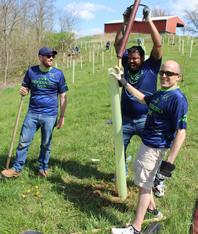
• Diversity and Inclusion: Employees, regardless of generation, recognize the importance of creating an inclusive environment. An inclusive workplace where individuals of all backgrounds are respected and valued is essential for retention and engagement.
Q5: What are some practical ways to assess and improve generational inclusivity within an organization?
To ensure inclusivity across generations, organizations should regularly assess employee engagement and inclusivity. Here are some questions companies can use to gather feedback:
• Do you feel valued and respected for your contributions within the team and organization?
• Do you feel comfortable speaking up and sharing your ideas, concerns, and feedback with your team members and leadership?
• Are there any barriers or challenges that you face in fully participating and engaging in team activities or decision-making processes?
• How do you perceive the level of diversity and inclusivity within the team and organization as a whole?
• What steps or initiatives do you believe could be implemented to enhance diversity, equity, and inclusion within the workplace?
By recognizing the strengths each generation brings to the table and creating opportunities for collaboration, organizations can build stronger, more dynamic teams. The key to success lies in fostering an inclusive environment where every employee, regardless of age or background, feels valued and empowered. Through mentorship, open communication, and a commitment to diversity, businesses can ensure that the collective power of their multigenerational workforce drives innovation, growth, and success.
IN PARTNERSHIP

by April Bartel
Frederick Innovative Technology Center, Inc. (FITCI) reached a significant milestone in 2024, celebrating two decades of impactful work in the region.
What began as a small incubator on the third floor of Hood College in 2004 has blossomed into a multifaceted hub for entrepreneurs with more than 70 clients that span technology, biotech, science and sustainability sectors. With an unwavering commitment to fostering healthy economic growth and supporting local entrepreneurs, FITCI stands as a catalyst for success and a community cornerstone. Its mission remains clear: to elevate Frederick’s entrepreneurial community and contribute to a vibrant, prosperous regional economy.
On Oct. 17, 2024, nearly 300 people gathered to honor FITCI’s 20-year legacy. The celebration took place at FITCI’s new 21,000 square-foot facility. Maryland’s EDGE at 321 Ballenger Center Drive is a space that embodies the organization’s growth and vision. The facility took five years to create and it reflects a strong collective effort of “130 dedicated people, representing 27 companies putting in more than 25,000 woman- and man-hours,” according to CEO Kathie Callahan Brady.
“It truly took a village,” she said, “and this is just the beginning.”
A $4.6 million grant from the U.S. Economic Development Administration was pivotal in funding the effort, especially as the initial $5 million project estimate doubled, then tripled, as construction costs surged around the pandemic. The facility’s final cost came in at just over $9 million, thanks to many in-kind donations from generous business ecosystem members and the team’s creative budget-reduction strategies –such as driving across the country to pick up

Designed for flexible workspace, conferences and events, Base Camp is where Frederick’s entrepreneurs can collaborate, learn, and grow together.
and refurbish used essential equipment at a fraction of the cost of new goods.
For all its high-tech amenities, The EDGE at 321 is more than just a space — it’s a bustling entrepreneurial environment, complete with 25 offices, 20 private laboratories, 18 shared lab benches, and
a 4,200-square-foot community area known as Base Camp. Designed for flexible workspace, conferences and events, Base Camp is where Frederick’s entrepreneurs can collaborate, learn and grow together.
“The entrepreneurial journey can be lonely,” says Callahan Brady, “but here, you continued next page
can connect, share, and grow with others who understand your challenges.”
The thoughtfully designed expanse represents FITCI’s commitment to building community connections and breaking down barriers to entry, providing local entrepreneurs with accessible, affordable resources in a welcoming environment. It’s a way for early-stage startup entrepreneurs to take advantage of a structured support system.
FITCI has long focused on three pillars: Coaching, Capital and Connections. Now, FITCI takes it a step further by emphasizing customer insight and the importance of understanding market trends.
FITCI’s Strategic Growth and Advisory Board (SGAB) is a unique and invaluable resource. These roundtable discussions connect clients with seasoned CEOs who serve as mentors and advisors, like a board of directors. SGAB’s 40 dedicated volunteers offer advice tailored to the specific challenges each business faces. The value of this program cannot be overstated, and connections remain long after graduation, helping founders refine strategies, tackle challenges, and maintain accountability as they grow.
FITCI is more than an incubator/ accelerator—it’s a comprehensive support system with programs that enable founders to flourish. Programs such as Startup-U, the EDGE Accelerator, IDEA Lab, and Reality Check (FITCI’s version of “Shark Tank”) are tailored to different stages of the entrepreneurial journey. FITCI also offers a unique “soft landing” program through the Maryland Global Gateway, giving foreign companies a structured and affordable way to enter the U.S. market. This initiative, supported by local economic development departments, provides international businesses with essential resources, facilities and advisors, helping to ensure a smooth market transition.
One recent participant, PRONAV Clinical, a clinical supply chain company, considered expanding from Ireland to Frederick. More than 30 local CEOs volunteered to share insights on Frederick’s


business climate, illustrating the region’s supportive and collaborative environment. FITCI continues to demonstrate that business in Frederick is about more than just location; it’s community-driven and filled with people who genuinely want to help each other succeed.
FITCI’s impact on the local economy is substantial. Since the pandemic, FITCI client companies raised $160 million and contributed an additional $84 million to the local economy. During the last two decades, FITCI companies created more than 1,300 direct jobs and an estimated
830 indirect jobs. Its graduates boast a 93% success rate, testament to the power of cooperative support and learning. The organization also has a remarkable 97% retention rate, with 80% of clients coming through referrals, illustrating the high level of trust FITCI has earned within the entrepreneurial community.
Frederick’s reputation as a burgeoning biomanufacturing hub is growing alongside FITCI. With companies such as Kite Pharma and other life sciences organizations calling Frederick home, the area has become a magnet for innovation in Maryland. Frederick’s high quality of life, excellent schools and proximity to major


Now with the new facility up and running, leadership is turning its sights to renovating the 4539 Metropolitan Court location into a biomanufacturing center with mezzanine space for the next level of growing companies in Frederick.

urban centers make it an ideal place for growing businesses.
Now with the new facility up and running, leadership is turning its sights to renovating the 4539 Metropolitan Court location into a biomanufacturing center with mezzanine space for the next level of growing companies in Frederick.
Base Camp and the Education Lab at Maryland’s EDGE open the way for more collaboration with local schools and colleges to nurture the next generation of entrepreneurs and life science professionals. Member companies like CELLS (Community Enrichment Laboratory for Learning Sciences), Serious About Science,
and Living Well Youth Works are also dedicated to advancing STEM education and creating opportunities for at-risk youth, offering young people hands-on learning experiences in FITCI’s professional lab setting and exposing young minds to the world of life sciences.
The future of FITCI and its vibrant community of client companies is deeply intertwined with the prosperity of Frederick and the broader Maryland region. Efforts that start here ripple far beyond local borders, extending positive impacts across the nation and beyond as the groundbreaking innovations researched and developed at FITCI go to market. 3

FITCI’s community is represented by a new mascot, Skylar Peakpreneur von FITCI. This mountain goat embodies the tenacity and resilience of startup entrepreneurs. As Callahan Brady explains, “Entrepreneurs are not delicate chicks needing to be protected in an ‘incubator.’ They are the tenacious, brave mountain goats scaling steeps cliffs and climbing to the top of the tallest mountains.” Skylar represents the grit and ambition required to build a successful business.


by Chris Slattery

In the Mental Health Association’s 60 years in Frederick County, its focus has been on education, advocacy, empowerment and treatment.
In serving the community MHA is guided by its mission “to build a foundation of emotional wellness for the whole community by preparing resilient children, securing vulnerable families and standing with people to face crises together.” It aims to provide services and assistance needed to make lasting positive change.
Over the decades, the society’s awareness of what mental health is and how it impacts our lives, families, businesses and community has evolved.
MHA’s new CEO Bridget Krautwurst took the helm in late September following a national search by a committee cochaired by board treasurer Scott McCaskill and former board president Guy Fletcher. Former CEO Shannon Aleshire retired at the end of June after a 25-year career with the MHA, the last 10 as the CEO.
As MHA’s new leader, Krautwurst says she’s leaning in to the shift in awareness about mental health.
“I feel like we’re on the cusp of what we can know and what we can do,” Krautwurst said. “There’s still a lot of stigmas out there, still a lot of fear. I really would love to see people get to a point where a mental health situation in your life is handled the exact same way you would handle the flu, or a heart condition.”
No one questions an appointment with an oncologist or a cardiologist, she points out, and mental health appointments should hold the same respect.
“There should never be a question when you say, ‘I want to go see a psychiatric nurse practitioner,’ a therapist, a counselor, a psychiatrist. It should be just another way we are taking care of our bodies because this is what our body needs to lead a happy and healthy and grounded life,” she said, adding that the connection between physical and mental health is strong.
continued next page
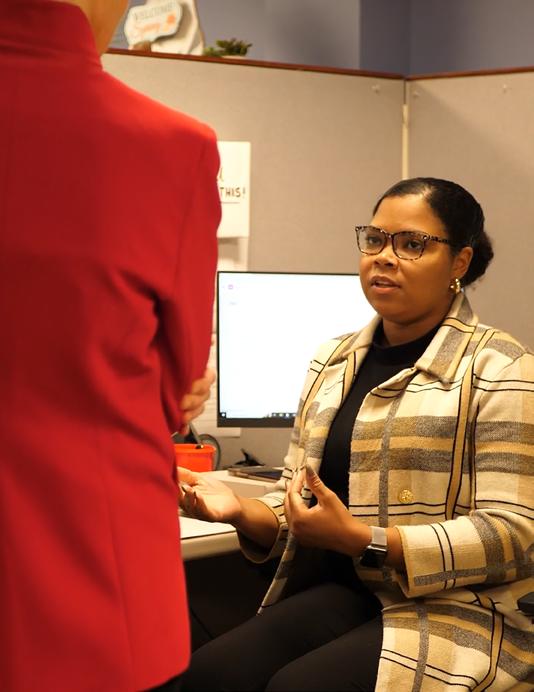
“There should never be a question when you say, ‘I want to go see a psychiatric nurse practitioner,’ a therapist, a counselor, a psychiatrist. It should be just another way we are taking care of our bodies because this is what our body needs to lead a happy and healthy and grounded life.”
- Bridget Krautwurst, CEO
Krautwurst was born in Louisiana’s Cajun country and was raised in Maryland. She always knew she wanted to work in the medical field.
“Healthcare was always part of my wheelhouse,” she said.
She became a registered nurse more than 20 years ago, and rose through the ranks to administration, but never forgot the impact mental healthcare had on her patients and on her colleagues at the hospital.
Mental health became “exceptionally important for me. It hits every aspect of life: personally, with family and friends; but watching the women that we served, the nursing and medical staff. You had your second grievers, you had your trauma responses, when we would lose our patients or something traumatic would happen within the workplace.
“Learning how to navigate that, and watching post-partum depression and anxiety rates soar — that became part of what I really wanted to focus on.”
She’s just starting out at the MHA, but Krautwurst says her new position is “fantastic.
“I don’t necessarily feel like I ‘go to work’ every day — what we do here is impactful, and it’s meaningful.”
Providing potentially life-changing resources makes the challenges MHA staffers face worth the effort, she says, and getting the word out about what the organization offers is critical. Krautwurst wants to make sure the community is aware of the services MHA can provide, to individuals and workplace groups alike.
“We would absolutely love to partner with organizations and do educational series to help bring awareness to the community,” she says. “We do a lot of outreach, one of my teammates right now is actually doing a speaker session on mental health in the workplace.”
MHA also offers a 24-7 walk-in crisis center, offering counselors to help with just about any mental health issue, any time of the day or night.
“If you aren’t feeling safe,” says Krautwurst, “there’s a safe space to go, where someone will support you in a crisis and guide you through.”
“If you aren’t feeling safe, there’s a safe space to go, where someone will support you in a crisis and guide you through.”
- Bridget Krautwurst, CEO


“Higher retention rates, higher engagement rates, higher employee satisfaction, higher client satisfaction, higher productivity rates,” says Krautwurst. “When you invest in your people, the return on your investment is there; it’s huge.”
An EAP provides voluntary, confidential services directly to employees who need help. Created in the 1940s to combat alcoholism in the workplace, today’s EAPs can assist employees undergoing everything from financial stress and bereavement issues to substance abuse and mental health disorders.
When choosing which health benefits to offer employees, make sure to include choices that support mental health. If that’s not possible, let employees know that resources like the ones MHA offers are available on a sliding payment scale.
MHA can put businesses in touch with speakers to address a host of mental health concerns, and setting up a lunch and learn event is a great way to build camaraderie while informing employees about the resources that are available.
The stigma surrounding mental health issues makes it more difficult for all of us to get the help we need. By fostering a workplace where prejudice and discrimination against people with mental health disorders aren’t tolerated, employers, managers, and workers can send a message of hope and acceptance, and create a better work environment for everyone.
Thanks to organizations like MHA, even the smallest businesses can provide a lifeline to employees (and customers) in need of mental health assistance. Just as MHA reaches out into the community, community leaders can raise awareness of what’s available — in a mental health crisis or on a daily basis — to those who are looking for assistance.

“Your socio-economic situation should not be a hindrance to getting the health care that you need.”
- Bridget Krautwurst, CEO
She also notes that MHA offers a sliding scale fee schedule, making it ideal for people who don’t have medical insurance or for those whose insurance do not cover mental health treatments. Grants, donations and other alternative sources of funding allow MHA to offer free and lowcost options to patients in need.
“Your socioeconomic situation should not be a hindrance to getting the healthcare that you need,” Krautwurst says.
MHA’s marketing team has put together a digitized online resource guide to help with problems such as food scarcity, homelessness, abusive relationships and more. The information is available for anyone to access, whether they’re experiencing these mental health adjacent problems themselves or want to strengthen the human resources available to colleagues and employees.
MHA has a program that reaches out by phone to elderly and disabled members of the community for wellness
checks. Another program trains volunteers support early childhood teachers and caregivers. And in high-conflict domestic situations, the MHA offices are available for supervised visitation to help alleviate conflict and keep children safe.
“There’s a lot!” the new CEO exclaims.
This is a dynamic organization whose staff and volunteers are doing their best to reach and serve every part of the community. 3
We believe in making a difference where it matters most—right here in our community. Our commitment to community empowerment has inspired us to support two impactful local initiatives: sponsoring a STEM Center in Carroll Manor Elementary School and joining hands with Habitat for Humanity to build safe, welcoming homes for families at the West All Saints Street Project.

Through our volunteer work with Habitat for Humanity, we’re building hope. Our team members actively contributed their time and expertise to construct affordable, safe, sustainable homes, offering families the stability they need to thrive.
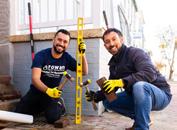
Our STEM Center sponsorship is about more than funding; it’s about sparking a lifelong love for science, technology, engineering, and mathematics. This space provides young minds with hands-on learning experiences, helping children imagine the future and feel empowered to shape it.

For us, investing in the community is a promise to support and uplift the people around us. Together, we’re nurturing the builders and dreamers of tomorrow and creating spaces for every family to feel at home.
Discover more about our efforts at rowanfrederick.com and let us know your thoughts—we’d love to hear from you!
By Ron Cramer

Ron Cramer, Ron Cramer is an empowering leader whose beliefs are embedded in the service to humanity is the best work of life. Ron has lived, worked and played in Frederick County all his life, 34 years with State Farm Insurance and 14 years as CEO of Habitat for Humanity of Frederick County.
Having grown up on a dairy farm in Frederick County, I’ve been blessed to call this community home my entire life. My first job beyond the farm was as an usher at the old Fredericktowne Mall Cinemas. At $2.75 an hour, it wasn’t much, but it taught me the value of hard work, patience, and making connections in the community.
I first interacted with Rowan Digital Infrastructure at one of their open house events. I was immediately impressed with their openness towards all the residents in our neighborhood — a neighborhood close to where they planned to build a data center. It was clear to me that before they built a data center, they wanted to build trust with the community.
My values were built over the years living here in rural Frederick County, and Rowan clearly shares many of them. Rowan understands that strong relationships are essential, and have intentionally built bridges with labor unions, business groups, environmental advocates, and nonprofits across the region.
I’ve seen that the company is committed to being a genuine partner in the communities they operate in, prioritizing environmental sustainability, investing in educational and job training programs, and making a meaningful impact right here in Frederick. The company knows that if it’s done right, smart growth has the power to lift up communities like ours.
Throughout my career, I’ve sought roles that uplift and support our community, including my time with Habitat for Humanity of Frederick County. I started with Habitat as a volunteer and board member, later serving as ReStore Manager. When the housing market crashed in 2008, I took on the role of Executive Director, launching programs like the Habitat Home Repair and Neighborhood Revitalization Initiative to partner with families for safe, affordable housing.
One of my proudest achievements was establishing the Frederick County Affordable Housing Land Trust — the first in Maryland — to make home ownership accessible to more people.
In my new role as Rowan’s community affairs specialist, I look forward to building and strengthening connections within the Frederick County community so that we can build opportunity for all. This place will always be my home, and Rowan’s commitment to responsible growth, environmental care, and strong local relationships assures me that we’ll continue to see Frederick County flourish as an inclusive and vibrant community.
SPONSORED CONTENT

•
•
•






By Katie Stevens, Director, Frederick County Office of Agriculture

Katie Stevens, the Director of the Frederick County Office of Agriculture, brings a wealth of experience and passion to her role. Her primary focus involves championing agricultural opportunities and acting as a crucial liaison between the industry and the county. For the last nine years, she has developed programs that support Frederick County Agricultural operations, including the Ag Innovation Grant Program, Homegrown Frederick, and the Frederick County Craft Beverage Program. Katie’s roots in agriculture run deep, as she grew up on her family’s dairy farm. Today, she and her husband enjoy farming with their three daughters, continuing their family tradition.
As Frederick County continues to evolve, preserving farmland to sustain and grow our agricultural economy and local food and fiber supply remains a key focus for Frederick County Government. In October 2023, County Executive Jessica Fitzwater proudly announced the creation of an Office of Agriculture during her State of the County Address marking the end of her first term. This announcement showcased the County Executive’s commitment to elevating the industry while providing enhanced support for farmers and agricultural businesses. The Office held its official ribbon-cutting in February 2024 and has been hitting the ground running ever since.
Comprised of two teams, Business Development and Agricultural Preservation, Office of Ag staff work to support farmers in preserving their land while also sustaining or growing their business operations. The Business Development team provides business retention, expansion, attraction, and marketing support, along with administering Frederick County’s Agriculture Innovation Grant Program. The Agricultural Preservation team assists farmers and landowners in applying for programs to preserve the county’s agricultural heritage for future generations.
Under County Executive Fitzwater’s leadership, her commitment to agriculture is steadfast and clear, ensuring that the industry remains a vital part of Frederick County’s landscape and economy. Preserving agricultural land not only supports the farming community but also promotes local food production, protects the environment, and maintains the rural character cherished by so many Frederick County residents.
In a significant step toward farmland preservation, during County Executive Fitzwater’s 2024 State of the County Address in October, she announced an ambitious goal to increase the county’s preserved acreage from the previous target of 100,000 acres by 2040 to 160,000 acres by 2051. This decision aligns with recommendations from the County Executive’s Transition Report.
Since July 2024, Frederick County has preserved more than 1,100 acres through the Rural Legacy Program, Conservation Reserve Enhancement Program, Frederick County’s Installment Purchase Program, and the Maryland Agricultural Land Preservation Foundation. Additionally, the county recently surpassed the 75,000-acre milestone for permanently preserved land—a landmark achievement underscoring the County’s dedication to sustainable agricultural growth. continued next page

For over 30 years, the Critical Farms Program has played a pivotal role in supporting local farmers. Established in 1994, this program was designed to help full-time farmers acquire farmland, leveling the playing field as they compete with non-farming buyers who often have access to greater resources. To date, the Critical Farms Program has assisted 66 farmers in purchasing farms and has preserved more than 9,600 acres of farmland.
The Office of Ag anticipates a Critical Farms application deadline early in the new year. Farmers seeking to participate in the program must have a ratified contract of sale on a farm that meets the program’s minimum criteria. By enabling farmers to acquire land and preserve it for future agricultural use, the program remains a key part of the county’s preservation strategy, directly contributing to broader acreage preservation goals. Farmers interested in this program should stay connected for the exact deadline and can contact Shannon O’Neil, Agricultural Preservation Program Administrator, at soneil@ frederickcountymd.gov or 301-600-1411 for more information
The holiday season provides an excellent opportunity to support Frederick County’s local agricultural and craft beverage businesses. Now is the perfect time to express gratitude for the Homegrown Frederick businesses that provide food, fiber, beverages, experiences, and services to our community. Agricultural businesses make up the largest commercial industry in the state, and in Frederick County alone, the industry has an economic impact of over $1 billion and generates $45.9 million in tax revenue, according to the 2022 Impact of ResourceBased Industries on the Maryland Economy report.
Support local this season by shopping small and investing in Frederick County’s economic viability and rural heritage. Consider cutting your own Christmas tree from a local farm, exploring fresh, local products directly from farms for holiday meals or gift-giving, or even signing a family member up for a Community Supported Agriculture (CSA) subscription. Additionally, Frederick County’s craft beverage businesses offer unique local drinks that can add a special touch to holiday celebrations or make memorable gifts. Each local purchase contributes to a thriving agricultural sector and strengthens the community. For more information on how to support local, visit www.HomegrownFrederick.com.
As we move into the new year, Frederick County’s Office of Agriculture remains committed to preserving farmland and promoting the local agricultural industry. We look forward to a vibrant, agriculturally rich future for generations to come in Frederick County. If you’re a farmer, agricultural landowner, or ag business and would like to learn about the Office of Agriculture services, contact us at 301-600-3039 or fcag@frederickcountymd.gov.
To everyone passionate about Frederick County’s agricultural story and sourcing local products, join our community! Follow us on Facebook (Frederick County Office of Agriculture / Homegrown Frederick) and Instagram (@homegrownfrederick) for the latest updates, inspiring stories, and ways to connect with local agriculture.
IN PARTNERSHIP

by

Experience award-winning and unique Maryland wines that have set the standard for deliciousness and quality in the fast-growing Maryland wine industry. Winemakers, owners, and expert staff will be on hand during the Grand Tasting, Master Class Sessions and Sponsored Events to talk about their wines and to offer a peek into why they’re so passionate about what they do.

by Sarah

The Bethesda-based residential and commercial architecture firm has opened a new office to facilitate projects in the Frederick area
GTM Architects is an awardwinning firm based in Bethesda, but is also known locally for its cutting edge, yet history-honoring, renovations. The recent opening of a new office at 8 E. Second St., in Frederick, is a strategic expansion that underscores the firm’s commitment to enhancing its service and project support within the region.
Since its founding in 1989 by George Thomas Myers, GTM Architects has garnered acclaim for delivering 35 years of innovative residential and commercial designs throughout the Washington, D.C. area. The firm’s robust portfolio also includes the transformation of Frederick’s own historic Coca-Cola bottling plant into The Bottling Plant Apartments — a project that received the Multifamily Grand Winner from the Frederick County Building Industry Association and FRED Modern Masterpiece Award — demonstrating GTM Architects’ expertise in revitalizing and modernizing landmark properties. Originally built in 1947, the Coca-Cola bottling plant had been vacant since 2008. GTM Architects revitalized the abandoned structure and transformed it into a vibrant mixed-use development, which now includes the restaurant Cugino Forno on the first floor along with office space on the second floor. This industrial-meets-Art Deco renovation was the inspiration for the newly constructed apartment complex, which sits at the rear of the property and features four stories of luxury apartment living.
“While we have completed multiple projects in Frederick for years now, we are excited to be opening an office downtown,” says Steven Sorrell, CID, LEED AP, VP Commercial Interiors of GTM Architects and Frederick County resident. “We also look





GTM was tasked with the preservation and adaptive reuse of the existing buildings, as well as the design of several additions to create a new building lobby and to replace a previously collapsed portion of the third floor.
forward to further solidifying ourselves as members of this great community and to be partners in its future growth.”
GTM Architects is renowned for its impactful projects in Frederick, such as the Union Knitting Mills historic restoration, renewing the 1890s building and tailoring an interior space, earning honors from the Frederick County Landmarks Foundation, NAIOP DC|MD, as well as MEDA Economic Development Project Award and FRED Modern Masterpiece Award. Union Knitting Mills is a 53,000 square foot mixed-use project located along Carroll Creek which now can incorporate office, retail and restaurant uses. The historic brick structures, built between 1889 and 1925, were the site of the Union Manufacturing Company knitting mill. GTM was tasked with the preservation and adaptive reuse of the existing buildings, as well as the design of several additions to create a new building lobby and to replace a previously collapsed portion of the third floor. The historic brick detailing and original freight elevators were also restored, while new windows and structure were integrated with existing building components. The


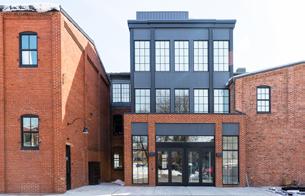




Established in 1989, GTM Architects is an award-winning design firm offering full architecture, interior design and planning services within its Residential, Commercial, Commercial Interiors, and Multifamily studios. Always committed to the needs and visions of its clients above all else, GTM’s team possesses a wide array of fine-tuned skills across vastly diverse styles and specialties, while also incorporating the latest technology and energy efficiency. To learn more, visit www.gtmarchitects.com.
“GTM has been working in Frederick for several years now, and we truly enjoy the community and jurisdiction. ”
- Jeff Whitman, Principal at GTM Architects
heavy timber trusses remain exposed along with the historic brick facades which dance beautifully with the addition of modern materials.
Other notable works include the Fort Detrick Navy Federal Credit Union, Carroll Creek Montessori Public Charter School, HOTWORX fitness studio, Yakabod and FCF Church. The firm’s deep-rooted presence and accomplishments in the area highlight its dedication to excellence and community investment in Frederick.
Jeff Whitman, principal at GTM Architects, reflects on the significant milestone adding, “GTM has been working in Frederick for several years now, and we truly enjoy the community. We look forward to continuing to expand our current range of projects in the area, including schools, multi-family, retail, restaurants and office spaces.” 3
Brunswick is strategically situated near West Virginia and Virginia, attracting traffic not just from Frederick County but also from out of state. Explore the diverse range of real estate options available for lease or sale—including retail, office, and industrial spaces— at brunswickmainstreet.org/brunswickproperties.
Be part of the exciting revitalization of Downtown Brunswick! Ongoing efforts are enhancing the appeal of our core business district, making it a vibrant place for commerce. Brunswick Main Street also offers grants to assist local businesses with building improvements, ensuring a flourishing environment for all.
Brunswick Main Street is dedicated to your success. We provide promotional opportunities to boost your visibility and organize ribbon-cutting ceremonies to celebrate your grand opening. Additionally, we can guide you in identifying funding resources to help launch and expand your business.

Take the leap and invest in a community that values your success. Come be a part of our small town’s bright future!

Learn more about starting and operating a business in Brunswick at brunswickmainstreet.org/locatingin-brunswick
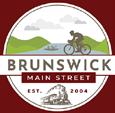


by Mark Kraham
What started as an afterschool program for immigrant families in 2004, has grown into a dynamic center serving the needs of immigrants as they adapt to life in America and journey toward becoming U.S. citizens.
The Asian American Center of Frederick has grown from a staff of one person to 35 employees and more than 200 volunteers during the last two decades. AACF has the capacity to speak 40+ languages and represent more than 25 countries.
As the organization has grown so has its community outreach and services. AACF offers programs such as early childhood education, ESL classes, Citizenship Integration Services, and language and translation services.
The Early Childhood Education program at the AACF Family Support Services Center focuses on building families as a strong unit. While children ages 6 months to 4 years are engaged in activities parents are participating in English classes.
“The program fills a vital need in the community, especially with the growing number of immigrants in the region,” said Jamie Guida, director of Family Support Services. “It’s become a place where friends become family.”
Adapting to life in a new country can be a challenge for many and AACF strives to make the transition as easy as possible. AACF Citizen Integration Services offers citizenship classes that equip people to be
continued next page
ready to become voting, taxpaying, U.S. citizens giving back to their community. ESL classes are coupled with the citizenship instruction to support the immigrant to a greater degree.
Language barriers can cause confusion and frustration in trying to achieve basic communications. AACF provides interpreter and translation services in a variety of settings. Common translation needs arise in medical, legal and business settings. In-person interpreters are available in most situations. Additional language translation services are available remotely.
Too often older persons are affected by Isolation and loneliness. Two programs administered by AACF are designed to provide companionship and offer opportunities for older adults to give back to their community.
The AmeriCorps Senior Companion Program focuses on providing assistance and friendship to older adults who are lonely or have difficulty with daily tasks, such as shopping or paying bills. Through this program, volunteers enrich lives, keep seniors independent longer and provide respite to family caregivers.
AACF is among six organizations in Maryland administering an apprenticeship program via the Apprenticeship Building America program under the U.S. Department of Labor. Apprentices receive on-the-job training while prospective employers receive an additional worker during the training period.
AACF also sponsors the Annual Frederick Community Health Fair. The 17th event was in early October. Through a partnership with Frederick Health along with other agencies and organizations, the annual health fair offers easy access to a variety of services such as blood pressure, cholesterol, glucose and other screenings. The health fair was created with the idea of helping people who may not have easy access to healthcare due to language or other barriers. Each year the health fair has grown to the point that thousands have received screenings and referrals to follow up heath services.
AACF also supports various cultural festivals each year.
Adapting to life in a new country can be a challenge for many and AACF strives to make the transition as easy as possible. AACF Citizen Integration Services offers citizenship classes that equip people to be ready to become voting, taxpaying, U.S. citizens giving back to their community.


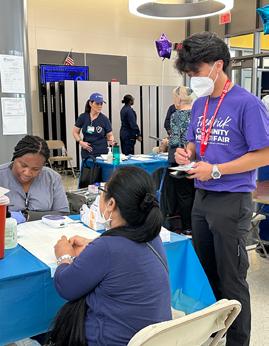
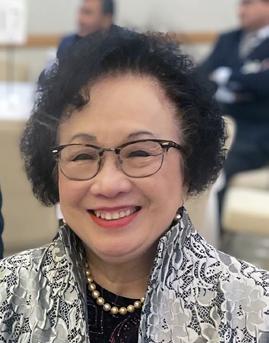
Language barriers can cause confusion and frustration in trying to achieve basic communications. AACF provides interpreter and translation services in a variety of settings. Common translation needs arise in medical, legal and business settings. In-person interpreters are available in most situations.



For 2 billion people around the world, the annual Lunar New Year celebration has great significance. Fond memories of family gatherings, food, cultural songs, and dances immediately come to mind.

AACF organizes the Asia on the Creek event at the Carroll Creek Amphitheater each May, designated Asian American Heritage Month. The event allows the community to explore cultural diversity through food, traditions and stories.
For 2 billion people around the world, the annual Lunar New Year celebration has great significance. Fond memories of family gatherings, food, cultural songs, and dances immediately come to mind.
The Asian American Center of Frederick is inviting the public to join in the Lunar New Year celebration at Frederick Community College, on Feb. 15, from 2 to 4 p.m.
Colorful costumes, entertaining dances, and Chinese drummers will be part of the entertainment. The traditional Dragon Dance officially welcomes the new year. Attendees will learn about the history of the celebration and hear stories from the past as others relive memories of previous celebrations. 3
CORPORATE MEMBERSHIP PROGRAM
YMCA OF FREDERICK COUNTY


CORPORATE OPPORTUNITIES AT THE YMCA Partnerships and Corporate Sponsorships Corporate Membership Volunteer Opportunities





From stunningly complex reds and vibrant whites to unique meads, ciders and fruit wines, Maryland wineries offer a wine for every palate.
And the Maryland Wineries’ Association is looking forward to showing off the best of what the state’s winemaking industry has to offer during its three-day premier event this spring, A Maryland Wine Experience, being held for the very first time in Downtown Frederick.
“The committee was attracted to Frederick’s vibrant downtown, and thought that the city and county’s strong commitment to supporting craft alcohol producers made this a great new option for this event,” said Jon Zerivitz, senior marketing strategist for the association.
Unlike other local wine events and festivals, A Maryland Wine Experience features scheduled wine education sessions, as well as a grand tasting highlighting wines from vineyards and wineries throughout Maryland, in addition to a collection of wines from abroad for comparative tastings and exploration.
The event debuted in 2022 in Annapolis as a way to help winemakers, owners and staff offer a peek into why they are so passionate about what they do.
The association represents more than 80 wineries from across the state and many of those wineries will be represented at A Maryland Wine Experience.
“We hope to attract wine consumers from Maryland, the Mid-Atlantic, and from across the country to Frederick for
this three-day event,” Zerivitz said. “Frederick is a destination city, and our intent is to grow this event over the years, and Frederick offers a location to do just that.”
A Maryland Wine Experience will be hosted at the new Visitation Hotel in Downtown Frederick, set to open this spring, with some classes held at Tenth Ward Distilling Company just a few blocks away.
Zerivitz said the new hotel opening made it possible to host the event in Frederick for the first time, providing a focal point in the vibrant downtown.
A Maryland Wine Experience will be held Friday, March 21, through Sunday, March 23.
The event includes two Master Class Sessions and access to the Grand Tasting, featuring dozens of Maryland-grown wines and wines from abroad.
Past master class sessions have allowed attendees to learn how to create their own Bordeaux blend and take away their own small bottle of customized wine, as well as get an understanding of how to pair Chesapeake Bay oysters, and all the flavors that they present, with local wines.
Winemakers, winery owners and winery staff will be on hand to talk about their wines and focus on educating attendees about why Maryland wines are so special.
For more information about the Maryland Wine Association and A Maryland Wine Experience, visit https:// marylandwine.com.





























At
Are









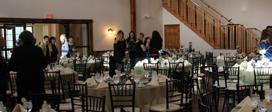

Perched atop one of the highest ridgelines in Gettysburg, framed by historic wood and stone architecture and stunning views of historic Gettysburg battlefields and Hunter Lake, The Lodges at Gettysburg is a destination unlike any other in the area.
It’s peaceful here with a timeless tranquility and rustic elegance that settle you into a relaxed state of mind. Beautifully maintained grounds and lodging, surrounded by 63 acres of rolling Gettysburg countryside, with a dash of historic charm – the perfect backdrop for corporate team building, outside-the-box meetings and extended stay conferences.


With a county population of 300,000 and 13 golf courses, Clustered Spires has earned “Best of Frederick Golf Course” for the 3rd straight year and our 17th time out of 20 years! Golf Digest awards Clustered Spires a HHHH rating. Clustered Spires reputation is a great conditioned golf course with wonderful greens and considered the best value golf course in central Maryland.








